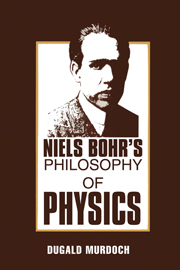Book contents
- Frontmatter
- Contents
- Dedication
- Preface
- Acknowledgements
- 1 Wave-particle duality
- 2 Niels Bohr and wave-particle duality
- 3 From duality to complementarity
- 4 The meaning of complementarity
- 5 The foundations of kinematic-dynamic complementarity
- 6 Bohr's theory of measurement
- 7 Bohr's theory of properties
- 8 Einstein versus Bohr
- 9 The sequel to the Bohr-Einstein debate
- 10 Bohr's philosophy of physics
- 11 An appraisal of Bohr's philosophy of physics
- Notes
- Index
1 - Wave-particle duality
Published online by Cambridge University Press: 01 June 2011
- Frontmatter
- Contents
- Dedication
- Preface
- Acknowledgements
- 1 Wave-particle duality
- 2 Niels Bohr and wave-particle duality
- 3 From duality to complementarity
- 4 The meaning of complementarity
- 5 The foundations of kinematic-dynamic complementarity
- 6 Bohr's theory of measurement
- 7 Bohr's theory of properties
- 8 Einstein versus Bohr
- 9 The sequel to the Bohr-Einstein debate
- 10 Bohr's philosophy of physics
- 11 An appraisal of Bohr's philosophy of physics
- Notes
- Index
Summary
Niels Bohr's theory of complementarity was an attempt to solve the enormous problems of interpretation – especially the problem of wave particle duality – that beset the quantum theory in the mid-twenties. By 1920 electromagnetic radiation could be conceived of either in terms of the wave model or in terms of the particle model, though neither conception alone was wholly adequate to the empirical data. By the mid-twenties the duality problem was quite general, applying to matter as well as to radiation. Quantum mechanics, the new quantum theory, could be interpreted partially in terms of one or other of the two models but not comprehensively in terms of either.
Bohr's theory can be fully understood only against the background of the interpretative problems which it was intended to solve; and the root of these problems goes back to the very origin of the quantum theory, viz. the quantum hypothesis to the effect that in certain physical processes energy is transferred discontinuously in discrete amounts. Wave-particle duality was a development of the continuity-discontinuity duality which the quantum hypothesis introduced into physics. How did wave-particle duality arise?
- Type
- Chapter
- Information
- Niels Bohr's Philosophy of Physics , pp. 1 - 15Publisher: Cambridge University PressPrint publication year: 1987



